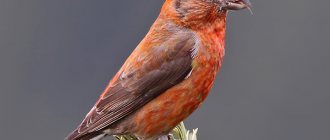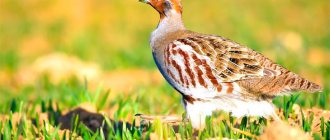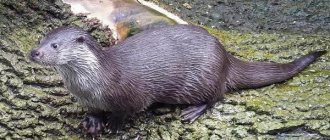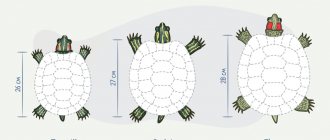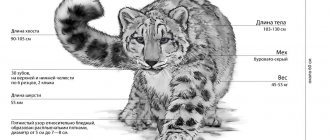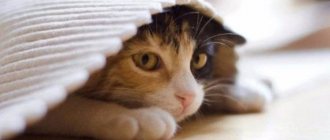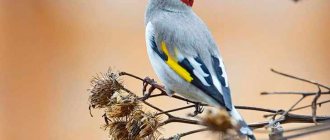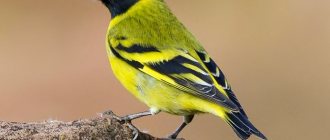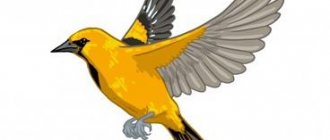Description of the bird
The motley and songbird of the finch family got its name goldfinch (lat. Carduelis carduelis) for two reasons. The first of them is her unusually sophisticated and bright, smart outfit. The second reason relates to the bird's Latin name. “Carduus” in Latin means thistle, the seeds of which this handsome fellow loves to feast on.
How to distinguish the goldfinch from its no less vocal relatives in the finch family - siskins, redpolls, and greenfinches?
— Advertising —
This bird is also small in size, about the size of a sparrow. The weight of adult goldfinches is about 20 g, body length is up to 12 cm, and the wingspan is about 22-25 cm. Goldfinches have a very dense, compact body with a round head, a short neck and a sharp small beak.
Their main difference from other species is the presence of bright yellow, red, black and white colors in their plumage. An adult goldfinch has two decorations on its head - a cap of black feathers and a burning red beak border. Males have such a rim wider than females, thanks to which they can be distinguished, since they are otherwise the same. The goldfinch's cheeks are white, the back is brown, and the belly is reddish. Its tail and wings are jet black with yellow spots and white stripes.
General characteristics and appearance
This representative of the finch family is a relative of the familiar sparrow. Ornithologists know that this name unites a large number of lines, among which greenfinches and redpolls, linnets and even siskins stand out. But the most common species remains the common goldfinch (aka black-headed). It is even smaller in size than a sparrow: an adult grows to 10, maximum 12 cm “from beak to tail,” and this with a weight of only 17-20 g. Such a fragile build is compensated by its appearance. The bright red color of the front of the head contrasts with the white cheeks and the black tone of the back of the head with the crown. The beak is red and white, with a black tip and dark “whiskers” at the base. It is noteworthy that in adult birds in this area you can see a red ring, while in young birds there is no such decoration due to their age.
Unknowingly, the goldfinch can easily be confused with the American siskin and other related species. When purchasing, be sure to pay attention to the red fragments in the design of the head - they indicate that this is a goldfinch.
The abdomen is reddish-brown (less often brown) and is similar in color to the chest. The white rump looks impressive against the background of a black tail with white specks. The wings stand apart - they are yellow (according to the color of the transverse stripes), and in their rear part there are alternating black and white small spots. Such a handsome man rests on his dark yellow, almost brown paws. Having found out exactly what the song goldfinch looks like, it is logical to ask how it behaves in nature.
Goldfinch singing
A loud and ringing melody, consisting of various and unique trills - this is how the goldfinch sings. All goldfinches sing unusually beautifully and clearly, only greenfinches hum slightly when singing and make quieter sounds. The song of linnets is considered the most complex in terms of trills and the most melodic, but only males sing and sing exclusively in a flock. All goldfinches sing, sitting on a tree branch or on a tall bush, and while singing they are constantly in motion, spinning and bowing in different directions. The goldfinch's singing, restlessness and bright appearance are the reasons why people like to keep it at home.
Nutritional Features
Like other members of the finch family, goldfinches are granivorous birds. In nature, they feast on the seeds of wild herbs - thistle, dandelion, burdock, sunflower, chicory, cornflower. The sharp and small beak allows goldfinches to even peck seeds, for example, from alder cones.
— Advertising —
Goldfinches feed their chicks with small insects. And they themselves sometimes add them to their diet.
LIFESTYLE
The goldfinch mainly prefers open areas, and therefore its favorite habitats are clearings, roadside bushes, light groves and abandoned gardens. At the beginning of the nesting period, flocks of goldfinches break up into married couples and small groups. During the rest of the time, goldfinches stay in flocks, which often move to cities in autumn and winter. Some birds migrate to the Netherlands, Belgium, France, Spain and Portugal - countries with a warm climate.
Distribution in nature and migration
Goldfinches have chosen many regions to live in. Europe, Asia, North Africa, the Caucasus, Western Siberia... Wherever this bird is found! But goldfinches do not like to migrate. Birds prefer habitable and familiar places, and therefore fly only in extreme cases of severe cold. Then goldfinches from northern latitudes travel to the southern latitudes.
In all areas of their distribution, goldfinches choose light edges of deciduous forests, parks, and gardens for living and nesting. They do not like dense thickets, but settle where there are a lot of grasses and weeds growing in order to get their food - various seeds.
Bird species
— Advertising —
The two main types of goldfinches are the black-headed and the gray-headed. Thick-billed and Yemen goldfinches are also distinguished separately. In addition, there are many subspecies of this bird.
Black-headed goldfinch
The black-headed goldfinch is the most common species of goldfinch. Its main habitat includes Europe, Western Asia and North Africa. The black-headed goldfinch is also called common and is used to determine a kind of “standard” for the appearance of this bird. A small, knitted body, a black cap on its head, white cheeks, a red edging of its beak, black and yellow wings - this is exactly what the classic black-headed goldfinch looks like.
Grey-headed Goldfinch
Permanent resident of Asia and Siberia. It differs from its relative in its larger size and less bright color. The plumage of these birds is dominated by brown and gray shades, pure colors - white, black - are absent. But the red rim around the beak, like the calling card of the species, is also characteristic of the gray-headed goldfinch.
Goldfinch - a pet
The goldfinch is a popular house bird. The bright and beautiful appearance of the bird, undemanding diet - this is what attracts bird lovers to the goldfinch bird. Singing makes him an even more desirable pet. A bird that has heard the trills of its relatives at least once will also chirp beautifully by the time it grows up. Although each such song will certainly begin with a not very pleasant whistle and chatter. Caught goldfinches very quickly get used to their new habitat and become tame. In addition, they are quite easy to teach various tricks.
Differences between female and male goldfinches
Goldfinches have weakly expressed sexual dimorphism. The female is only slightly lighter than the male, but has a more melodic and iridescent singing. That is why songbird lovers are advised to keep female goldfinches. In addition, the red border around the beak of females is narrow and does not reach the eyes, unlike the male.
Goldfinches vary much more depending on their habitat conditions. Those that live in northern latitudes are usually larger and paler in color, while southern goldfinches are bright and small.
Reproduction of goldfinches
From the beginning of winter until mid-April, birds gather in flocks (more than 40 individuals) and fly short distances in search of food. With the onset of spring, the bird flock splits into temporary pairs. At the end of May, the construction of the nest is completed. Typically, a home for offspring is made on horizontal branches of a tree, far enough from the trunk and high from the ground. It is interesting that the goldfinch (a bird whose photo can be seen in this article) builds a very beautiful and cozy nest for its future offspring. This is a very elegant and unusual building. The shape of the bird house resembles a cup with dense walls. For their construction, very thin plant stems are used, as well as roots and cobwebs. It is with soft poplar fluff that the goldfinch lovingly covers the bottom of the nest. The bird uses multi-colored moss, pieces of birch bark or lichen to camouflage itself from ill-wishers. Usually the nest of these birds turns out to be approximately the same color as the tree itself. Therefore, it is practically invisible from the ground. But the approximate location of the nest can be determined by the behavior of the birds, in particular the male goldfinch. He sits down at the very top of the tree, poplar or aspen, on which the bird's house is located, and quickly chirps his song. After all, at their core they are songbirds. Male goldfinches make all sorts of body movements during the song period. They turn from side to side, bend over, as if bowing. And if at this time a female flies up from the nest, the goldfinch rushes to her, spins and chirps. The female puffs up her plumage and shakes her wings. After mating, the female lays 4 to 6 eggs 16-18 mm long. Different species of goldfinches have eggs that differ in color; they can be:
- White with reddish specks.
- Greenish.
- With a blue tint.
Keeping a goldfinch at home
The goldfinch is not only beautiful and harmonious, but also has a peaceful and friendly character. This is why it is so popular among bird lovers as a pet.
For a handsome goldfinch you will need a cage at least 50 cm long with two levels and various perches and crossbars. In nature, goldfinches rarely fall to the ground; they prefer to always fly and be on the move, so it is important to create comfort for them at home. In addition, the goldfinch needs a lot of light and is afraid of drafts. All this must be taken into account when placing the cage. If the bird behaves restlessly at first, cover the cage with a light-colored cloth.
Goldfinches also need a large drinking bowl and a separate bathing container.
Goldfinch in captivity
As we have already found out, there are woodfinches. But today it is quite popular to have a feathered pet. Goldfinches are best suited for this role. This is due to the bright colors of the plumage, unpretentious diet and amazingly beautiful vocal qualities.
It is enough for a chick to hear the trill of an adult at least once in order to learn to sing amazingly as it grows. If you catch a goldfinch in the forest, it will very quickly domesticate and become tame. The bird also easily learns various tricks.
Diet for the goldfinch
The diet of goldfinches will be an equal mixture of seeds of spruce, pine, hemp, dandelion, sunflower, and plantain. Canary mixture is also perfect for goldfinches. During the molting period, add animal food - small insects and mealworms, mineral supplements - chalk, clay, shell rock, raw eggshells, green food - vegetables, fruits, herbs.
The birds are fed small portions twice a day. And in order to pamper the goldfinch, prepare a mixture of grated boiled carrots and eggs.
Goldfinches, like all granivores, need a lot of water, which is changed twice a day.
Goldfinch Breeding
If several male and female goldfinches are placed in a large cage, they can create pairs and breed offspring. The nest is built by a female goldfinch. To do this, she needs to put building material in the cage - feathers, blades of grass, pieces of bark, twigs.
In one clutch, the goldfinch contains up to 5 small bluish or greenish eggs, from which chicks are born after two weeks of incubation. They grow and become stronger for about 20 days, and then leave the nest.
Where do goldfinches live?
A male and female goldfinch in the garden on a blooming golden (black) currant bush.
In the wild, goldfinches prefer to live on the edges of forests, in gardens and parks, and copses. This is due to the fact that the goldfinch’s favorite food is hemp and burdock , as well as quinoa, tall thistle and wormwood, which do not grow under the shade of forests, so goldfinches are forced to scour the village outskirts, looking for food in abandoned farmsteads overgrown with weeds.
American Goldfinch - photo
The goldfinch bird, like other songbirds, such as siskins, makes its nests in trees in the forks of branches, on the edges of the same copses, gardens and parks.
Where to buy goldfinch?
Where do goldfinches come from into our homes? From markets and shops, most often these are birds caught in various snares by amateur bird catchers. I must say that catching songbirds is like a disease. Once you become addicted to it, holding in your hands this small, trembling creature trying to fight with you, you risk joining the ranks of bird catchers forever. Why is this bad, you ask, for example, my father forbade me to catch birds in childhood only because he himself had difficulty “getting over” them, sliding from excellent students to poor students and truants, almost staying in school for the second year.
The father first ran away from classes to check the snares, and then began skipping school altogether. Instead of school, I ran to the wasteland to catch goldfinches. Therefore, I advise you to read the story by Mikhail Prishvin - “The Turlukan Goldfinch”, you will learn a lot of useful things about this smart and proud bird, as well as how goldfinches are caught and how beautifully they sing. You can download or read Mikhail Prishvin’s story “The Goldfinch Turlukan” here. You can also watch the video - how to catch goldfinches , it is at the bottom of the page.
Goldfinches have lived in our house since I can remember. In the fall, they most likely appeared from the market; my father did not catch goldfinches in my presence, although the wings and flap cages were always kept in the barn. In winter they lived in a spacious cage, sometimes in an aviary, their chirping always reminded me of summer. By spring, they were already pecking seeds from their hands and flying freely around the house, climbing into the cage only for the night. But in the spring the most interesting thing began: the cage with the goldfinches was hung out on the street, the door was opened, but the goldfinches did not fly away until a flock of their brothers appeared nearby, and the flock arrived precisely at their call.
Goldfinch chick
It was very interesting to watch how our goldfinches looked for a mate. They rushed between the flock and the cage, brought the pair into their cage, flew away, but returned in the evening to roost for the night. This went on for about two weeks, but the most interesting thing is that after about a month and a half, maybe a little more, not only our pet goldfinches, but also their offspring came to visit.
You know, the goldfinch is a surprisingly very contradictory bird, freedom-loving, at first, like the siskin, unwilling to live in captivity, pugnacious, choosing a leader in the flock and unquestioningly obeying him. But meanwhile, the goldfinch is a bird faithful to its owner, able to recognize him and find its home, like a homing pigeon.
Therefore, I recommend about
